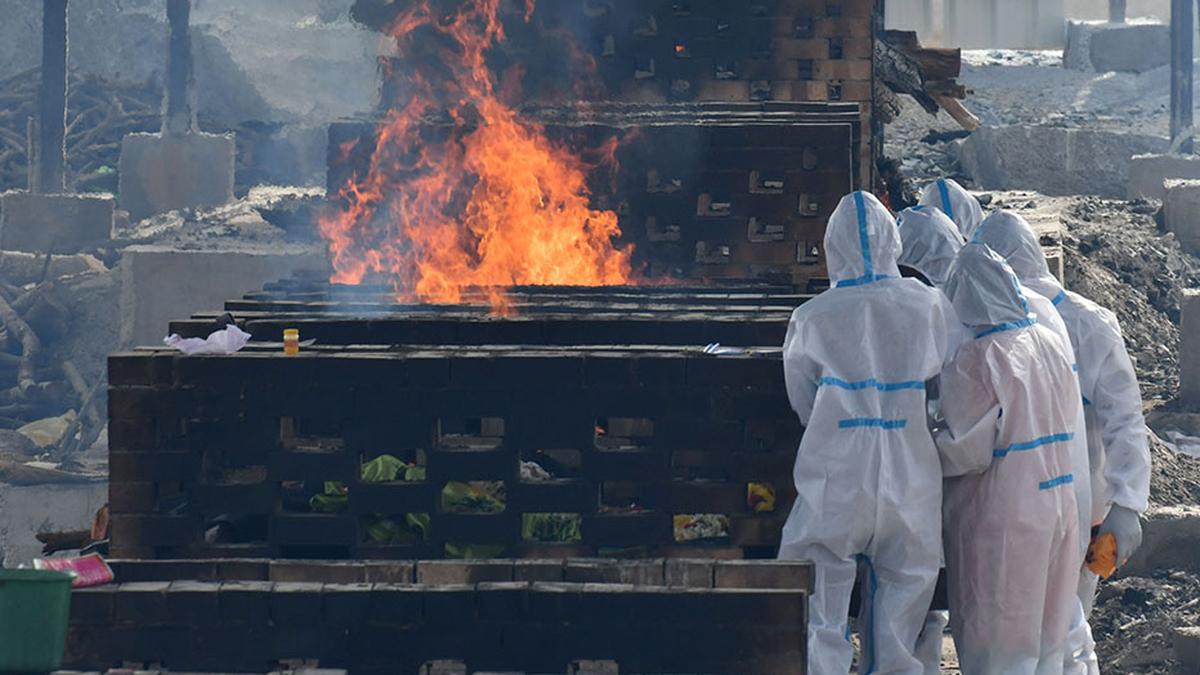Family members perform the last rites of a COVID-19 victim at a temporary crematorium on the outskirts of Bengaluru in May 2021.
| Photo Credit: The Hindu
The Civil Registration System (CRS) data has brought into sharp relief the magnitude of excess mortality that India witnessed during the COVID-19 pandemic years. Excess mortality refers to the difference between the total number of deaths during a pandemic or any other natural disaster compared to the number of deaths that would have been expected under normal conditions. According to the CRS, India recorded 76.4 lakh deaths in 2019. This figure rose to 81.11 lakh in 2020 and further surged to 1.02 crore in 2021 — an implicit acknowledgement of the fact that the true mortality impact of COVID-19 far exceeds the official toll of 5.33 lakh.
Data from the Medical Certification of Cause of Death (MCCD) for 2021, released alongside the CRS and Sample Registration System reports, adds further weight to this claim. COVID-19 was identified as the second leading cause of death, with 5.74 lakh certified fatalities attributed to the virus — already exceeding the official figure. However, this estimate was drawn from less than a quarter (23.4%) of registered deaths in 2021. Taken together, the rise in all-cause mortality and the limited scope of medical certification offer a compelling case that India’s true pandemic death toll may be far closer to the World Health Organization’s estimate of 47 lakh deaths — a model that the Government of India had earlier rejected, citing concerns over its methodological robustness.
A systemic deficiency
CRS data/all-cause mortality data is indispensable, especially given the widespread undercounting of COVID-related deaths. This metric captures not only confirmed cases but also fatalities arising from misdiagnoses, misclassification, and pandemic-induced systemic disruptions. Nonetheless, the utility of the all-cause mortality data in gauging the true impact of COVID-19 is limited in the Indian setting, as the recording of deaths is far from universal. The National Family Health Survey-5 states that nearly 29% of deaths between 2016 and 2020 went unregistered. The omission of civil registration from the list of essential services during the 2020 lockdown further obscured the mortality landscape. As a consequence, even comprehensive datasets such as CRS may fall short in reflecting the full impact of the pandemic.
Editorial | A belated admission: On the undercount of India’s COVID-19 pandemic deaths
Beyond numerical discrepancies lies a deeper issue — the structural inadequacy of death certification and classification. During the pandemic years, we visited crematoriums and burial grounds in a locality in Kerala. We observed a marked rise in the number of daily cremations compared to previous years — an increase that was evident not only in facilities designated for handling COVID-19 deaths, but also in those without such designation. This raises pertinent questions regarding the misclassification of COVID-19 deaths and under-ascertainment of causes. A significant driver of this opacity is the absence of medical certification. In 2020, 45% of deaths occurred without any form of medical attention — 10% points higher than in pre-pandemic years. Within our study cohort, only 22.8% of the deceased had any formal medical documentation indicating the cause of death. Nationally, only 23.4% of deaths are medically certified as per the recent MCCD data. This systemic deficiency compromises mortality surveillance as well as public health planning.
Indirect deaths
A further dimension of the pandemic’s mortality burden relates to indirect deaths — a category of deaths that, while not directly caused by SARS-CoV-2 infection, can be reasonably attributed to the wider repercussions of the pandemic. These fatalities, often absent from COVID-19 official statistics, occurred due to systemic disruptions: delays in seeking care due to fear of infection, scarcity of hospital beds and essential medicines, post-infection complications, economic distress, and logistical barriers to healthcare access during prolonged lockdowns.
During our field study, we found that a considerable share of deaths was indirectly linked to these cascading effects of the pandemic. Many people suffered physical and psychological deterioration post-infection, some experienced an exacerbation of chronic conditions, and others refrained from seeking timely medical attention. When extrapolated to the broader national context, particularly in regions where healthcare systems are fragile and supply chains were acutely disrupted, the implications would be sobering. To gauge the true mortality impact of the pandemic, it is insufficient therefore to rely solely on officially recorded COVID-19 deaths or all-cause mortality data.
Also read | ‘Excess deaths in 2020 and 2021 not equal to deaths by COVID-19, increase attributable to several reasons’
Our study in Kerala found that 34% of deaths were indirectly attributable to the pandemic, and 9% may have been misclassified. If such patterns exist in a State with a relatively strong public health systems (although the death registration in the prescribed time was around 61% in 2021), the scale of undercounting could be even more pronounced in States such as Gujarat and Madhya Pradesh where discrepancies between excess deaths and official figures are significantly wider.
These findings make a compelling case for a systematic inquiry into the full extent of mortality during the pandemic. Policymakers should consider conducting a large-scale study, which could be also accomplished by including questions on decedents in the next Census. More importantly, they must serve as a wake-up call to urgently reform India’s mortality surveillance architecture.
Shilka Abraham, Master of Public Health graduate, School of Health Systems Studies, Tata Institute of Social Sciences; Soumitra Ghosh, Associate Professor and Chairperson, Centre for Health Policy, Planning and Management, School of Health Systems Studies, Tata Institute of Social Sciences
Published – August 05, 2025 01:00 am IST

